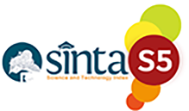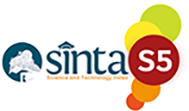Pengembangan Smart Learning Berbasis Sistem Pakar Pada Mata Kuliah Kriptografi
Abstract
 Abstract: The development of science and technology requires universities not only material but also have the ability in their respective fields including cryptography. To overcome the shortcomings in these learning activities, a project-based blended learning model was developed. The development carried out in this study uses the Puslitjaknov development model which reduces the Borg and Gall stages into five stages, namely product analysis, initial product design, expert validation and revision, field trials and implementation. The subjects of this study were STMIK Triguna Dharma students who took Cryptography courses in the 2020 academic year. Data was collected by means of interviews, observations, questionnaires and tests. Data analysis used quantitative and qualitative methods to produce products in the form of books, modules, lesson plans and manuals for using learning applications. Product validation by experts, practicality tests carried out by users and effectiveness tests with student learning outcomes. Based on the results of data analysis, the results of this study are: 1) Research has succeeded in developing a project-based blended learning model in cryptography courses. 2) The developed syntax learning model consists of 9 stages/syntax. 3) In supporting learning activities, DIKTAT, RPS and student guides. All products and models that have been developed and categorized are valid, practical and effective.Â
Keywords: Blended Learning, Project Base Learning, CryptografyÂ
Abstrak: Perkembangan ilmu pengetahuan dan teknologi menuntut perguruan tinggi tidak hanya sekedar materi tetapi juga memiliki kemampuan di bidangnya masing-masing termasuk kriptografi. Untuk mengatasi kekurangan dalam kegiatan pembelajaran tersebut, maka dilakukan pengembangan model blended learning berbasis proyek. Pengembangan yang dilakukan dalam penelitian ini menggunakan model pengembangan Puslitjaknov yang mereduksi tahapan Borg and Gall menjadi lima tahapan yaitu analisis produk, desain produk awal, validasi dan revisi ahli, uji coba lapangan dan implementasi. Subyek penelitian ini adalah mahasiswa STMIK Triguna Dharma yang mengambil mata kuliah Kriptografi pada tahun ajaran 2020. Pengumpulan data dilakukan dengan wawancara, observasi, angket dan tes. Data dianalisis menggunakan metode kuantitatif dan kualitatif untuk menghasilkan produk penelitian berupa buku, modul, rencana pembelajaran dan manual penggunaan aplikasi pembelajaran. Validasi produk oleh ahli, uji kepraktisan yang dilakukan oleh pengguna dan uji keefektifan dengan hasil belajar siswa. Berdasarkan hasil analisis data, maka hasil penelitian ini adalah: 1) Penelitian telah berhasil mengembangkan model blended learning berbasis proyek pada mata kuliah kriptografi. 2) Sintaks model pembelajaran yang dikembangkan terdiri dari 9 tahapan/sintaks. 3) Dalam menunjang kegiatan pembelajaran, DIKTAT, RPS dan panduan mahasiswa. Semua produk dan model yang dikembangkan telah dikembangkan dan dikategorikan valid, praktis dan efektif.Â
Kata Kunci: Blended Learning, Project Base Learning, KriptografiÂ
Full Text:
PDFReferences
T. Voronchenko, T. Klimenko, and I. Kostina, “Learning to Live in a Global World: Project-Based Learning in Multicultural Student Groups as a Pedagogy of Tolerance Strategy,†Procedia - Soc. Behav. Sci., vol. 191, pp. 1489–1495, 2015, doi: 10.1016/j.sbspro.2015.04.472.
H. M. Yongbin Zhang, Ronghua Liang, “Teaching innovation in Computer Netrwork Course for Undergraduates Students With PAcket Tracer,†Int. Conf. Futur. Comput. Support. Educ., vol. 2, pp. 504–510, 2012, doi: 10.1016/j.ieri.2012.06.124.
N. Linge and D. Parsons, “Problem  based learning as an effective tool for teaching computer network design Problem-Based Learning as an Effective Tool for Teaching Computer Network Design,†2006.
S. R. and L. C. D. H. Noel Davis capt and N. Through, “Teaching Computer Networks Through Modeling by,†Electr. Eng. Comput. Sci., 1996.
N. I. Sarkar, “Teaching Computer Networking Fundamentals Using Practical Laboratory Exercises,†Annu. Conf. NACCQ, New Zealand, Junu 2000, pp. 1–22, 2000.
J. Janitor, F. Jakab, and K. Kniewald, “Visual Learning Tools for Teaching / Learning Computer Networks Cisco Networking Academy and Packet Tracer,†pp. 351–355, 2010, doi: 10.1109/ICNS.2010.55.
J. Pan, “Teaching Computer Networks in a Real Network The Technical Perspectives,†SIGCSE10, pp. 133–137, 2010.
J. Ning et al., “Spatiotemporal patterns and characteristics of land-use change in China during 2010–2015,†J. Geogr. Sci., vol. 28, no. 5, pp. 547–562, 2018, doi: 10.1007/s11442-018-1490-0.
W. F. Marti, U. W. Pooch, and J. A. Hamilton, “PACKET tracing : a new paradigm for teaching computer network courses,†pp. 162–164, 1996.
L. l P. and B. Davie, “Computer Networks : A Systems approach,†Networks Telecommun., pp. 1–6, 2008.
R. K. C. Chang, “Teaching Computer Networking with the Help of Personal Computer Networks,†pp. 208–212, 2004.
Z. Ran, “Exploration on the Key Issues of Practical Teaching Reform of Computer Network,†vol. 17, pp. 1914–1919, 2012, doi: 10.1016/j.egypro.2012.02.332.
M. Syahrizad, A. Zamzuri, and M. Ali, “Survey on the Challenges Faced by the Lecturers in Using Packet Tracer Simulation in Computer Networking Course,†Procedia - Soc. Behav. Sci., vol. 131, pp. 11–15, 2014, doi: 10.1016/j.sbspro.2014.04.070.
X. Yu, “The Construction and Application of Simulation Teaching System for Computer Network Curricula,†IEEE, vol. 07, pp. 524–527, 2007.
D. Liu, P. Valdiviezo-dÃaz, G. Riofrio, and Y. Sun, “Integration of Virtual Labs into Science E-learning,†Procedia - Procedia Comput. Sci., vol. 75, no. Vare, pp. 95–102, 2015, doi: 10.1016/j.procs.2015.12.224.
N. Jovanovic, R. Popovic, S. Markovic, and Z. Jovanovic, “Web Laboratory for Computer Network,†pp. 1–10, 2010, doi: 10.1002/cae.20417.
A. Kayssi, S. Sharafeddine, and H. Karaki, “Computer-Based Laboratory for Data Communications and Computer Networking,†pp. 84–97, 2003, doi: 10.1002/cae.20002.
S. S. Kulkarni, “USING VOIP AS A COMMON FRAMEWORK FOR TEACHING A SECOND COURSE IN COMPUTER NETWORKS.†2007.
P. Sege, M. Kubina, and P. Palúch, “ViRo – the online tool for the networking education,†vol. 174, pp. 3788–3796, 2015, doi: 10.1016/j.sbspro.2015.01.1114.
A. H. Aldholay, Z. Abdullah, T. Ramayah, O. Isaac, and A. M. Mutahar, “Online learning usage and performance among students within public universities in Yemen,†Int. J. Serv. Stand., vol. 12, no. 2, pp. 163–179, 2018, doi: 10.1504/IJSS.2018.091842.
B. Collis and J. Moonen, “Flexible Learning in a Digital World,†Open Learn. J. Open, Distance e-Learning, vol. 17, no. 3, pp. 217–230, Sep. 2002, doi: 10.1080/0268051022000048228.
I. W. Santyasa, “Validasi Dan Implementasi Model-Model Student Centered Learning Untuk Meningkatkan Penalaran Dan Karakter Siswa Sekolah Menengah Atas,†JPI (Jurnal Pendidik. Indones., vol. 4, no. 1, pp. 512–527, 2015, doi: 10.23887/jpi-undiksha.v4i1.4890.
D. Purwanto, “Analisis Penilaian Tingkat Kesehatan Bank Pada Bmt Ums Dengan Metode Camel,†2007.
D. S. K. G. Jöreskog, LISREL 8: Structural Equation Modeling with the SIMPLIS Command Language. North Licoin Avenue, 1993.
H. J. Snippert et al., “Lgr6 marks stem cells in the hair follicle that generate all cell lineages of the skin,†Science (80-. )., vol. 327, no. 5971, pp. 1385–1389, 2010, doi: 10.1126/science.1184733.
“BEYOND,†vol. 36, no. 6, p. 2015, 2015.
M. Iswan, M. Syaifuddin, and R. F. Wijaya, “The Effectiveness of Smart Learning Based on Expert Systems in Cryptography Courses,†J. Teknol. Dan Open Source, vol. 4, no. 2, pp. 205–215, 2021, doi: 10.36378/jtos.v4i2.1795.
DOI: https://doi.org/10.46576/syntax.v3i1.2109
Article Metrics
Abstract view : 654 timesPDF – 275 times
Refbacks
- There are currently no refbacks.

This work is licensed under a Creative Commons Attribution-NonCommercial 4.0 International License.
Syntax: Journal of Software Engineering, Computer Science and Information Technology
Ciptaan disebarluaskan di bawah Lisensi Creative Commons Atribusi 4.0 Internasional.

















